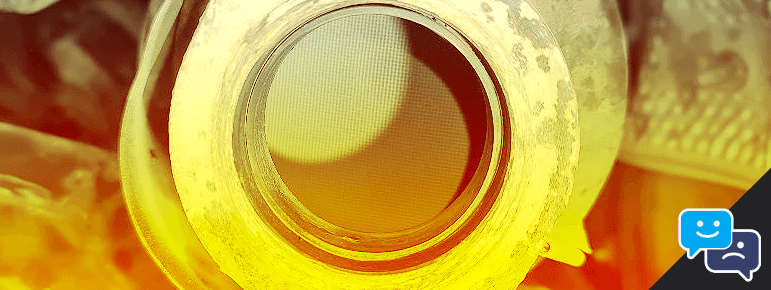Is your car’s check engine light on and your mechanic is telling you it’s because of a clogged catalytic converter? Don’t panic – it may just need a little TLC in the form of a catalytic converter cleaner. But what exactly is catalytic converter cleaner, and what are the signs it’s needed?
Catalytic converter cleaner is a liquid additive that is added to the fuel tank. It helps dissolve and clean deposits from a car’s catalytic converter and oxygen sensors, and restore lost engine performance and improve emissions. It is often used to fix a PO420 or PO430 check engine light trouble code.
The simple truth is, catalytic converters are essential for controlling vehicle emissions. They play a crucial role in keeping our air clean and preventing unpleasant odors from exiting the exhaust pipes.
And, if you are suddenly seeing a check engine light related to a PO420 or PO430 error code, it means that the oxygen sensors (O2 sensors) are showing low efficiency from the catalytic converter.
Simply put, this means that the catalytic converter is not doing what we’d expect from it – reducing emissions.
But don’t worry, you don’t have to shell out for an expensive new catalytic converter. All it needs is a good cleaning.
In this guide, we will explore the signs that indicate the need for catalytic converter cleaning, the benefits of using catalytic converter cleaners, and address frequently asked questions.
Then to wrap it all up, we will provide recommendations on where to purchase these cleaners.
Let’s jump into this!
What Are The Signs that Indicate the Need for Catalytic Converter Cleaner?
Perhaps the most common sign that your catalytic converter needs a good cleaning is a loss of engine power. This can often be pretty evident when driving up steep hills or trying to merge onto the highway. The car might just feel a bit sluggish.
And then of course, is the check engine light. If you are getting a PO420 or PO430 error code, it means the catalytic converter and O2 sensors are dirty.
Because of a build up of carbon on the catalytic converter, it means the catalyst on the catalytic converter is not able to reduce the amount of emissions that you’re car is putting out.
Truth is, catalytic converters can become clogged or inefficient over time due to the accumulation of carbon deposits and oil residues. Simply put, if your vehicle accumulates a high number of miles each year or if it consumes oil, expect a high likelihood of a dirty converter.
And don’t neglecting these signs, as it can lead to more severe damage to your vehicle’s exhaust system and engine.
Promptly addressing these symptoms can help prevent further complications later down the road. Not to mention save on fuel expenses and help keep our air clean too.
What Causes Catalytic Converters and O2 Sensors to Get Dirty?
So, why do catalytic converters and O2 sensors get all gunked up? Well, there are a few reasons. First off, if your engine isn’t burning fuel efficiently, you can end up sending carbon deposits down into the catalysis.
Another culprit is leaks. If your engine is consuming oil or coolant, those sneaky liquids can contaminate your the catalytic converter and O2 sensors. And prolonged exposure to oil or coolant will surely containment the converter and O2 sensors, leading to reduced power or check engine light.
Remember, these parts can also get dirty simply with age and usage too. With age and miles, even the best things in life need a little TLC.
So, if you notice your vehicle isn’t performing as it should, or your check engine light is on and glowing – it’s time to give those converters and sensors some love.
Does Catalytic Converter Cleaner Work?
If the converter is less than 10 years old, and you are getting the dreaded PO420 or PO430 check engine codes, then catalytic converter cleaner will help.
When used as directed, the cleaner will remove deposits from a functioning converter and help restore the efficiency.
Fact is, these cleaners are specifically formulated to remove carbon deposits and other contaminants, improving the converter’s ability to convert harmful gases into less harmful substances.
By utilizing a cleaner, you can reduce emissions, improve vehicle performance, and contribute to cleaner air and a healthier environment for all.
Is Catalytic Converter Cleaner Bad For the Engine?
Generally yes, as the main ingredients of these cleaners are typically acetone, isopropanol, xylene and kerosene.
Each one of these ingredients have been proven to be safe for use in internal combustion engines, hybrids, and diesel vehicles.
Rest assured, converter cleaners are formulated to be compatible with most fuel systems, and do not significantly alter or degrade the fuel.
How Safe is Catalytic Converter Cleaner?
Most catalytic converter cleaners available at the local auto parts store, or your dealership is safe to use. Generally, these cleaners are made up of detergents, solvents, and other cleaning agents.
And, as the vehicle is driven and the exhaust is heated up, the cleaner goes to work to loosen and remove deposits from the catalytic converter.
It’s actually a pretty simple process that can, over some mileage, improve the effectiveness of the converters and even remedy that pesky check engine light.
Where to Purchase Catalytic Cleaners?
When it comes to purchasing a catalytic converter cleaners, several options are available. Online stores specializing in automotive products are often a good choice. But also the local auto parts store will often have catalytic cleaners in stock ready for purchase.
How Much Does Catalytic Converter Cleaner Cost?
Catalytic converter cleaner prices can vary, but expect to pay between $10 and $40 for a single bottle or can. As with anything, premium or specialized cleaners may cost more.
Frequently Asked Questions about Catalytic Converter Cleaners
Can Catalytic Converter Cleaners Fix All Issues Related to Catalytic Converters?
While catalytic converter cleaners are effective in removing carbon deposits and contaminants, they cannot fix mechanical issues or damage within the converter itself.
In cases of severely damaged or clogged converters, it may be necessary to remove the converter to clean, or replace the bad catalytic converter.
However, this isn’t an easy process and will require mechanical experience. But it may very well safe you the cost of replacing the converter – which typically costs around $800 to $1,650 per converter.
How Often Should I Use a Catalytic Converter Cleaner?
Honestly, it depends on your vehicle’s usage and maintenance history. As a general rule it is recommended to use a converter cleaner every 10,000 to 15,000 miles.
However, its always best to consult with the manufacturer for usage recommendations for your specific vehicle.
Is it Safe to Use Catalytic Converter Cleaners With All Types of Vehicles?
Yes, any vehicle that has a catalytic converter as part of its exhaust system is generally safe to use converter cleaner. However, it is important to follow the instructions provided by the cleaner’s manufacturer to ensure compatibility and safe usage.
Obviously, if you drive an electric car there is no need for catalytic converter cleaner.
Are There Any Specific Instructions For Using Catalytic Converter Cleaners?
Yes, as different brands of catalytic converter cleaner may have specific instructions for usage. Carefully read and follow the instructions provided on the product label, as these instructions typically include details on dosage, application methods, and safety precautions.
Can I Use Catalytic Converter Cleaners as a Preventive Measure?
Yes, catalytic converter cleaners can be used as preventative maintenance every 10,000 to 15,000 miles, but is not required. Truth is, most vehicle owners typically only use them once signs of a clogged converter begin to appear.
Does Catalytic Converter Cleaner Clean O2 Sensors?
Generally yes, converter cleaner is also intended to remove deposits from O2 sensors and restore their accuracy.
How Much Does it Cost to Get a Catalytic Converter Unclogged?
The cost of unclogging a catalytic converter can vary depending on a few factors, like how bad the clog is, where the converter is located, and if the converter can be removed easily. Generally speaking, you can expect to pay anywhere from $100 to $500 or more.
However, if the clog is really bad or if the converter is damaged, you may need to replace it.
Ask your mechanic to to test for blockage, by accessing a pressure point before the catalytic converter, to install a back pressure gauge to measure the pressure.
Keep in mind, normal back pressure should be less than 9 kPa @ idle and less than 20 kPa @ 2500 RPM. A high reading means the catalytic converter may be damaged or blocked.

Final Thoughts
Catalytic converter cleaner can really help to restore your car’s engine performance and improve emissions of pollutants. It’s a great way to fix the PO420 or PO430 check engine light trouble codes without having to shell out for expensive new parts.
And by recognizing the signs that indicate the need for catalytic converter cleaning, you can address issues promptly and prevent further damage.
Fact is, catalytic converter cleaners offer a convenient solution for restoring efficiency and reaping various benefits, including improved engine performance, reduced emissions, and potential cost savings.
With reputable online stores and local auto parts stores offering a variety of options, purchasing catalytic converter cleaners has never been easier.
And don’t forget, an ounce of prevention is worth a pound of cure. Regular maintenance and periodic check-ups can often help prevent these problems before they start.
Did we miss anything? If so, drop us a comment below with your own advice for dealing with catalytic converters.

Managing Editor
Christopher is an automotive technical writer. When he’s not at the local autocross event, he can often be found working on one of his cars. Specializes in automotive class action law, industry trends, and automotive maintenance. Email me direct, or learn more about us

